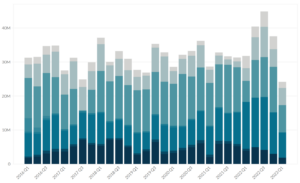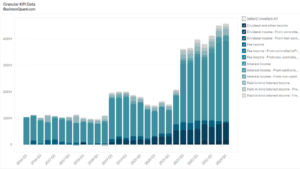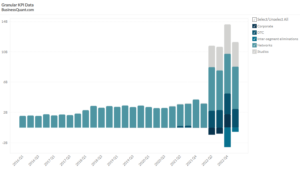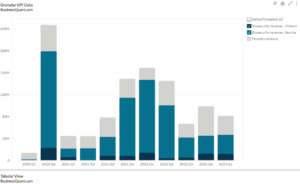
Nvidia’s Inventory Purchase Obligations (2017 – 2023)
Exclusive Data
You need the Pro Plan to access KPI data
- Full access to the platform
- KPI data & segment financials on US stocks
- Financial data on thousands of stocks
- Download data in xlsx and csv formats
Pro Plan
$49 per month*
60% discount ends in:
.
About
More information
Subscribe to Pro or Enterprise plans to unlock this feature.
Contact the Analyst
Subscribe to Pro or Enterprise plans to unlock this feature.
Become a smarter investor today.
Access KPIs & Segment Financials on US stocks
This article discusses Nvidia’s Inventory Purchase Obligations, reported on a quarterly basis from Q1 2016 onwards.
What are Purchase Obligations?
According to SEC’s Section 401(a) of the Sarbanes-Oxley Act of 2002, companies are required to disclose their contractual obligations in their SEC filings. The SEC defines a Purchase Obligation as an agreement to purchase goods or services in the future, that is enforceable and legally binding on the company, specifying all the significant terms and conditions. A firm’s purchase obligations represent the amount agreed to acquire goods and services from one or more suppliers; and is also designed to capture capital expenditure for purchases over the period of time in forecasted future. Purchase obligations is directly related to the expectation of future demand by a firm for their products. An increase in firm’s purchase obligation, it expects an increase in future demand for its products and services. Information regarding purchase obligations can be found in disclosures by management.
Purchase Obligations of Nvidia Corp.
As of July 26, 2020 (Q2 2020), Nvidia had outstanding inventory purchase obligation of $2.04 billion and other purchase obligation which also includes capital purchase obligation of $310 million. This means that Nvidia’s inventory purchase obligations accounted for 86% of its total purchase obligations. Also, Nvidia’s inventory purchase obligations rose 15.90%, or $0.28 billion, in Q2 on a sequential basis.
Table containing Nvidia’s Purchase Obligations (Q3 2019 – Q2 2021):
| Particular | Q2 2021 | Q1 2021 | Q4 2020 | Q3 2020 | Q2 2020 | Q1 2020 | Q4 2019 | Q3 2019 |
| Inventory Purchase Obligation (millions) | $ 2040 | $ 1760 | $ 1160 | $ 980 | $ 757 | $ 782 | $ 1330 | $ 1560 |
| Capital Purchase obligation (million) | $ 310 | $ 287 | $ 186 | $ 138 | $ 133 | $ 194 | $ 135 | – |
| Total Purchase Obligation (millions) | $ 2350 | $ 2047 | $ 1346 | $ 1118 | $ 890 | $ 976 | $ 1465 | $ 1560 |
| Increase in total purchase obligation (QoQ) (%) | 14.08% | 52.08% | 20.39% | 25.61% | (8.81%) | (33.37%) | (6.08) | |
| Increase in total purchase obligation (YoY) (%) | 164.04% | 109.73% | (8.12%) | (28.33%) |
Year-On-Year (YoY) increase for Nvidia’s inventory purchase obligation and capital purchase obligation were 168% and 133%, respectively. Inventory purchase obligation in Q2 2019 were $757 million and capital inventory obligation were $133 million. In recent quarters, Purchase obligations for Nvidia was the highest in Q2 2020, totalling $ 2350 million ($ 2.350 billion).
As stated above, there is a splendid increase of amount committed to purchase obligations in year 2021, indicating a healthy demand for products and services of Nvidia in foreseeable future. Nvidia is increasingly committing more and more funds towards acquiring goods from suppliers to fulfil the demand.
Company Overview:
Nvidia Corporation, is an American multinational technology company that focuses on personal computer (PC) graphics, graphics processing units (GPUs) for the gaming and professional markets, as well as system on a chip unit (SoCs) for the mobile computing and automotive market. Gaming, automotive electronics, and mobile devices are three core markets of business for Nvidia and company has created various platforms that addresses such markets. Nvidia is also now working on artificial intelligence and cloud services. In addition to GPU manufacturing, Nvidia has also developed CUDA – a parallel processing/computing platform for researchers and scientists that allow them to efficiently run high-performance applications.
You can access thousands of such granular datasets with Business Quant. Get started for Free.
More data on US Stocks

Our Plans
Always know what you’ll pay. No hidden costs or surprises.
- Annual
- Monthly
60% discount till April 30
Pro
For serious investing
-
Company KPI data Access segment financials, non-GAAP metrics and KPI data from presentations and filings. Examples include financials by segment / region / product category, AT&T's broadband subscriber trends, Tesla's deliveries by model and lots more.
-
Stock research tools Features include : stock screener, stock comparison, industry financials, stock warnings, advanced charting tools, timeseries tables, scatter charts, financial statements, stock reports, SEC filings, stock ratings, institutional and insider ownership data. There are 200+ financial items and ratios on thousands of US stocks.
-
Industry data & tools Access premium operating data on 40+ industries. Examples include market share, smartphone shipments by vendor, subscribers by wireless carrier, historical gold production. There are 20,000+ such statistics.
Enterprise
For tailored workflows
-
All of Pro plan Get unfettered access to all our dashboards and dossiers.
-
Custom built features Get tailored dashboards built specially for you , based on your set of requirements, to simplify your research workflow.
-
Admin billing Back-end documentation support and multi-seat licensing.
* Billed annually, local taxes extra.
60% discount on Annual plan
Pro
For serious investing
-
Company KPI data Access segment financials, non-GAAP metrics and KPI data from presentations and filings. Examples include financials by segment / region / product category, AT&T's broadband subscriber trends, Tesla's deliveries by model and lots more.
-
Stock research tools Features include : stock screener, stock comparison, industry financials, stock warnings, advanced charting tools, timeseries tables, scatter charts, financial statements, stock reports, SEC filings, stock ratings, institutional and insider ownership data. There are 200+ financial items and ratios on thousands of US stocks.
-
Industry data & tools Access premium operating data on 40+ industries. Examples include market share, smartphone shipments by vendor, subscribers by wireless carrier, historical gold production. There are 20,000+ such statistics.
Enterprise
For tailored workflows
-
All of Pro plan Get unfettered access to all our features.
-
Custom built features Get tailored dashboards built specially for you , based on your set of requirements, to simplify your research workflow.
-
Admin billing Back-end documentation support and multi-seat licensing.
* Local taxes extra.






